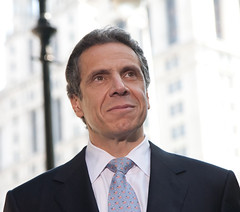
New York State’s 2012 draft budget gave transportation some much needed attention. If the plan is adopted, the state will dispense $4.4 billion to New York’s transit systems ($4 billion to the MTA and $430 million to non-MTA systems). The increase in aid comes from tax restructuring and revenue increases from various dedicated taxes (MMTOA) that pay for transit.
Here are some of the budget’s notable transportation components:
- Upstate transit systems get attention: upstate bus systems have long struggled to deliver service. Bus systems currently receive revenue from the petroleum business tax, which has brought in less money over the years. To address this, the Governor proposed a redistribution of the Transmission Tax (also known as the “Long Lines Tax”) more equitably between downstate and upstate systems. Instead of a yearly transfer of tax revenue between upstate and downstate, funds would be distributed based on population. This would bring in an additional $11 million in aid to upstate transit systems. NYSTEA and TSTC have pointed out that these systems need greater attention.
- The MTA gets paid back: thanks to pressure from transit advocacy groups, Governor Cuomo’s proposed budget keeps his promise to fill the $310 million gap in the MTA’s budget caused by the reformed payroll mobility tax deal in December. The restructuring worried transit advocates, who feared that the drop in yearly revenue would trigger another fare increase and service cut in 2012. State sources indicate that the MTA will be compensated for the full $310 million over the state’s fiscal year (which runs April 1 through March 31). The state would also reimburse the MTA for costs associated with an EZ Pass rebate program for Queens residents that use the Cross Bay Veterans Memorial Bridge.
- The MTA Capital Program gets additional state commitment: the state would give an additional $770 million over the remaining three years of the MTA’s construction effort. This aid would be accompanied by a $7 billion increase in the MTA’s debt ceiling (from $34 billion to $41 billion), which would finance the bulk of the capital program. State legislation is required for this action.
- Rail gets a boost in funding: the budget includes $26.6 million for “additional rail capital investments and support [for] Amtrak service subsidies.” This would help improve the state’s rail infrastructure and make high speed rail opportunities more conceivable.
- NYSDOT will be consolidated: in an effort to create a more seamless transportation vision throughout the state, the New York State Department of Transportation’s 11 regional offices would be consolidated to six. TSTC has long advocated for this measure. The budget notes that the consolidation would create efficiencies within the department, along with “…a new regional view that better reflects the needs of the state.” Hopefully, this will benefit urban areas and streamline the funding process for sustainable transportation initiatives between cities and the state.
- Tappan Zee bridge construction bill has not been resolved: the Governor reiterated his proposal to fund the Tappan Zee Bridge replacement project with $5 billion from a New York Works Infrastructure Fund, with the New York State Thruway Authority being the responsible entity. It is still unclear how the Thruway Authority would pay for the replacement, though increased tolls and taxes seem to be the most likely options. Meanwhile, BRTontheBridge.org was launched today to advocate for a bridge replacement plan that includes the public transportation communities need.

What is the status of the decision to include a lower deck on the new TPZ spans?
[…] Cuomo—New York’s governor came through on his promise to fill the MTA funding gap that was opened by last year’s Payroll Mobility Tax cut. The […]
[…] Legislators grew frustrated with New York State Department of Transportation (NYSDOT) Commissioner Joan McDonald at a hearing last week, bristling at what Senator Diane Savino (D-Staten Island/Brooklyn) called her “almost deliberate opaqueness” during a session about the department’s proposed 2012-13 budget. […]
[…] short-changes transit, New Yorkers can’t get to work. Increased state operating assistance in Governor Cuomo’s proposed budget could mitigate upstate service cuts, but the legislature must address long-term transit funding […]
[…] Yorkers can’t get to work. The good news is that the increased state operating assistance in Governor Cuomo’s proposed budget could mitigate upstate service cuts, but the rally served to remind the legislature that they must […]
[…] to generate $1 million in order to cover growing operating expenses, but Governor Cuomo’s proposed budget would give the county an additional $1.5 million for its bus system. This windfall presents an […]
[…] legislators work to negotiate between three separate visions for New York’s 2012-13 budget—Governor Cuomo’s, the Senate’s, and the Assembly’s—transit funding has assumed its usual place as a political […]